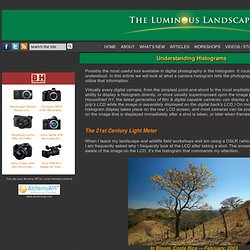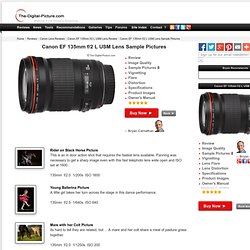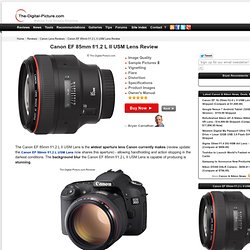

Home. Understanding Histograms. Possibly the most useful tool available in digital photography is the histogram.

It could also well be the least understood. In this article we will look at what a camera histogram tells the photographer and how best to utilize that information. Virtually every digital camera, from the simplest point-and-shoot to the most sophisticated digital SLR has the ability to display a histogram directly, or more usually superimposed upon the image just taken. (The Hasselblad H1, the latest generation of film & digital capable cameras, can display a histogram on the camera grip’s LCD while the image is separately displayed on the digital back’s LCD.) On most cameras though the histogram display takes place on the rear LCD screen, and most cameras can be programmed to do this both on the image that is displayed immediately after a shot is taken, or later when frames are being reviewed.
The 21st Century Light Meter In Bloom. Canon EOS 1Ds with 16-35mm f/2.8L lens @ 24mm. Dynamic Range. Digital Blending. This subject is featured in Issue #6 of The Luminous Landscape Video Journal.

The Problem Being Solved In nature when doing landscape work that includes sky, especially early or late in the day, the contrast range encountered often exceeds that which film or imaging chips can handle. It's therefore necessary to find a way to reduce the contrast range to something that the camera can handle so that the highlights don't burn out and the shadow areas don't turn inky black. The Traditional Approach The traditional method of dealing with this is to use split neutral density filters (graduated filters, some call them). This works well much of the time, and I have rarely gone out shooting without my full filter kit at the ready. 1 stop, 2 stop and 3 stop grads, and soft and hard edged versions of each. An additional downside is that using them takes time. Is there a better way? Shooting Technique What you're going to do is take at least two separate frames of the scene.
Common First Steps. Canon EF 135mm f/2 L USM Lens Sample Pictures. My Recommended Retailers Rent the Canon EF 135mm f/2 L USM Lens Do you need/want the Canon EF 135mm f/2 L USM Lens for only a short period of time?

Or, would you feel more comfortable buying after having a hands-on trial period? 5 Tips for Getting Sharper Images. An important element of photography is getting sharp, crisp images.

You may be struggling with focus, especially if you are fairly new to DSLR photography. It is extremely frustrating to go out shooting, assuming you’ve got nice clear, sharp images, only to get home to find out they aren’t quite as sharp, or even in focus, as you had hoped. Canon EF 85mm f/1.2 L II USM Lens Review. The Canon EF 85mm f/1.2 L II USM Lens is the widest aperture lens Canon currently makes (review update: the Canon EF 50mm f/1.2 L USM Lens now shares this aperture) - allowing handholding and action stopping in the darkest conditions.

The background blur the Canon EF 85mm f/1.2 L II USM Lens is capable of producing is stunning. It takes a lot of glass to be that fast - and it sure looks nice. It is especially attractive with that red ring around the end of it - showing it's L-Series membership. Canon EF 85 mm F1.2 L II lens (Mark II) Pre-PMA 2006: Canon has today announced the 'Mark II' version of its (monster) professional EF 85 mm F1.2 L II lens. This new version includes improvements to auto focus speed and communication of distance information for use with the E-TTL II flash metering algorithm. This lens should be available in March for approx. $2100. Jump to: Press Release: Canon f/1.2 ideal for portraits and low light Amstelveen, The Netherlands, 21 February, 2006: Canon today releases its latest professional L-series prime lens: the exceptionally fast EF 85mm f/1.2 II USM.